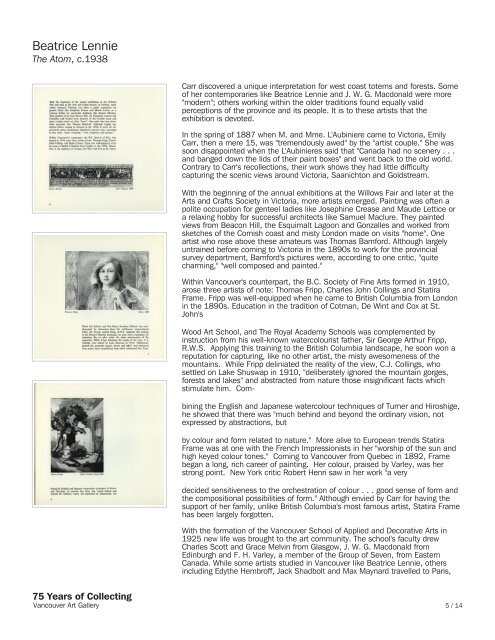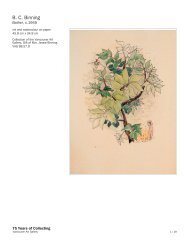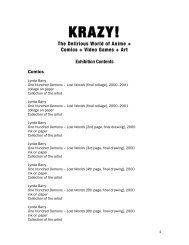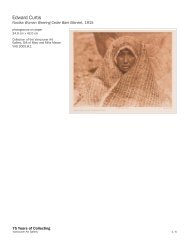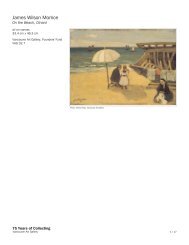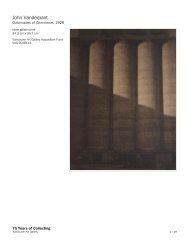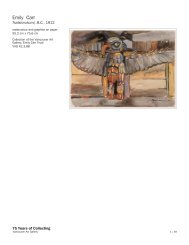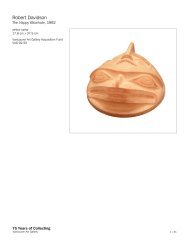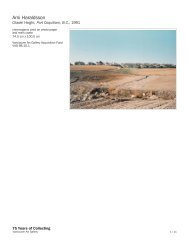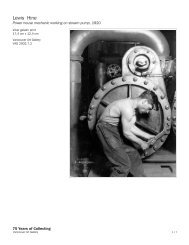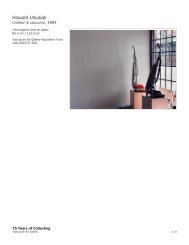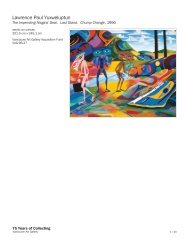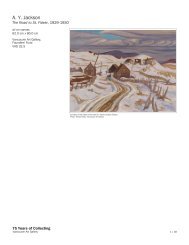Beatrice Lennie.pdf - 75 Years of Collecting - Vancouver Art Gallery
Beatrice Lennie.pdf - 75 Years of Collecting - Vancouver Art Gallery
Beatrice Lennie.pdf - 75 Years of Collecting - Vancouver Art Gallery
Create successful ePaper yourself
Turn your PDF publications into a flip-book with our unique Google optimized e-Paper software.
<strong>Beatrice</strong> <strong>Lennie</strong><br />
The Atom, c.1938<br />
<strong>75</strong> <strong>Years</strong> <strong>of</strong> <strong>Collecting</strong><br />
<strong>Vancouver</strong> <strong>Art</strong> <strong>Gallery</strong><br />
Carr discovered a unique interpretation for west coast totems and forests. Some<br />
<strong>of</strong> her contemporaries like <strong>Beatrice</strong> <strong>Lennie</strong> and J. W. G. Macdonald were more<br />
"modern"; others working within the older traditions found equally valid<br />
perceptions <strong>of</strong> the province and its people. It is to these artists that the<br />
exhibition is devoted.<br />
In the spring <strong>of</strong> 1887 when M. and Mme. L'Aubiniere came to Victoria, Emily<br />
Carr, then a mere 15, was "tremendously awed" by the "artist couple." She was<br />
soon disappointed when the L'Aubinieres said that "Canada had no scenery . . .<br />
and banged down the lids <strong>of</strong> their paint boxes" and went back to the old world.<br />
Contrary to Carr's recollections, their work shows they had little difficulty<br />
capturing the scenic views around Victoria, Saanichton and Goldstream.<br />
With the beginning <strong>of</strong> the annual exhibitions at the Willows Fair and later at the<br />
<strong>Art</strong>s and Crafts Society in Victoria, more artists emerged. Painting was <strong>of</strong>ten a<br />
polite occupation for genteel ladies like Josephine Crease and Maude Lettice or<br />
a relaxing hobby for successful architects like Samuel Maclure. They painted<br />
views from Beacon Hill, the Esquimalt Lagoon and Gonzalles and worked from<br />
sketches <strong>of</strong> the Cornish coast and misty London made on visits "home". One<br />
artist who rose above these amateurs was Thomas Bamford. Although largely<br />
untrained before coming to Victoria in the 1890s to work for the provincial<br />
survey department, Bamford's pictures were, according to one critic, "quite<br />
charming," "well composed and painted."<br />
Within <strong>Vancouver</strong>'s counterpart, the B.C. Society <strong>of</strong> Fine <strong>Art</strong>s formed in 1910,<br />
arose three artists <strong>of</strong> note: Thomas Fripp, Charles John Collings and Statira<br />
Frame. Fripp was well-equipped when he came to British Columbia from London<br />
in the 1890s. Education in the tradition <strong>of</strong> Cotman, De Wint and Cox at St.<br />
John's<br />
Wood <strong>Art</strong> School, and The Royal Academy Schools was complemented by<br />
instruction from his well-known watercolourist father, Sir George <strong>Art</strong>hur Fripp,<br />
R.W.S. Applying this training to the British Columbia landscape, he soon won a<br />
reputation for capturing, like no other artist, the misty awesomeness <strong>of</strong> the<br />
mountains. While Fripp deliniated the reality <strong>of</strong> the view, C.J. Collings, who<br />
settled on Lake Shuswap in 1910, "deliberately ignored the mountain gorges,<br />
forests and lakes" and abstracted from nature those insignificant facts which<br />
stimulate him. Com-<br />
bining the English and Japanese watercolour techniques <strong>of</strong> Turner and Hiroshige,<br />
he showed that there was "much behind and beyond the ordinary vision, not<br />
expressed by abstractions, but<br />
by colour and form related to nature." More alive to European trends Statira<br />
Frame was at one with the French Impressionists in her "worship <strong>of</strong> the sun and<br />
high keyed colour tones." Coming to <strong>Vancouver</strong> from Quebec in 1892, Frame<br />
began a long, rich career <strong>of</strong> painting. Her colour, praised by Varley, was her<br />
strong point. New York critic Robert Henri saw in her work "a very<br />
decided sensitiveness to the orchestration <strong>of</strong> colour . . . good sense <strong>of</strong> form and<br />
the compositional possibilities <strong>of</strong> form." Although envied by Carr for having the<br />
support <strong>of</strong> her family, unlike British Columbia's most famous artist, Statira Frame<br />
has been largely forgotten.<br />
With the formation <strong>of</strong> the <strong>Vancouver</strong> School <strong>of</strong> Applied and Decorative <strong>Art</strong>s in<br />
1925 new life was brought to the art community. The school's faculty drew<br />
Charles Scott and Grace Melvin from Glasgow, J. W. G. Macdonald from<br />
Edinburgh and F. H. Varley, a member <strong>of</strong> the Group <strong>of</strong> Seven, from Eastern<br />
Canada. While some artists studied in <strong>Vancouver</strong> like <strong>Beatrice</strong> <strong>Lennie</strong>, others<br />
including Edythe Hembr<strong>of</strong>f, Jack Shadbolt and Max Maynard travelled to Paris,<br />
5 / 14


